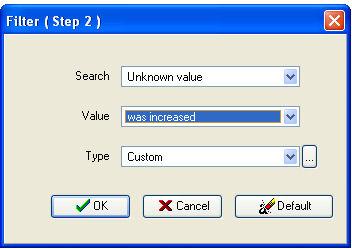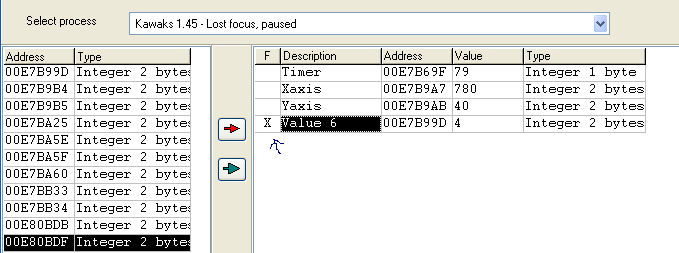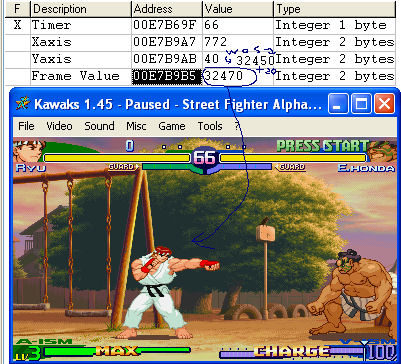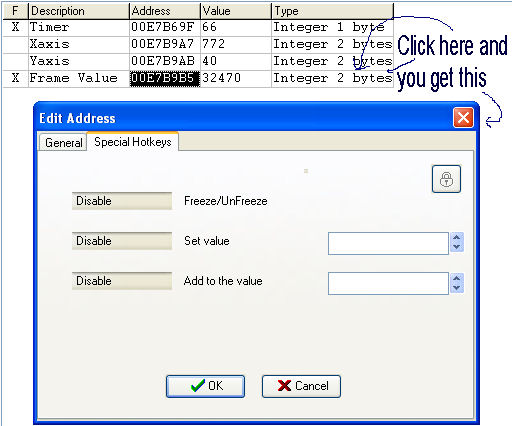Cycling through the
sprites.I got tired of searching in the
large range I showed above. I know all the values will
begin with 00E now so I am only gona search in that
range. In capcom games I havn't found anything game
related outside of the range you find the axis and timer
values.

In Melty Blood the screen turning dark
effect was FAR away from the rest of the game data so
this means narrowing down the searches may not ALWAYS
find a certain value depending on how it is stored in
certain games.
In every game I have tested the
numeric values of the stance are smaller than the duck,
which is also smaller than an attack. Knowing this can
be very usefull in isolating the sprite and animation
values.
First search for Unknown Value while your
player is standing.


Next make your player duck and FILTER for
INCREASED VALUE


Next make your player attack and FILTER
for INCREASED VALUE again

Now go back to duck and FILTER for
DECREASED VALUE


Now go back to standing and FILTER for
DECREASED VALUE

Now go back to ducking and FILTER for
INCREASED VALUE (basically you started over)
Keep
repeating these steps till you have narrowed your search
down enough for your liking.
Once again you will use
the freeze option to find the value

Once you freeze the correct value your
player will not move (animate) anymore. They may just
kinda jitter as if they are trying to go to their next
frame. In some games like for example SF3, SFA3, CVS2 on
Dreamcast, SFA3 on PSX, and MB ReAct you can cycle
through the sprites while the game is paused.
Elliminating the jitter problem.
In some games
(such as Melty Blood ReAct) the sprites are set up in
two groups. One for animations and one for each frame in
those animations.
That means to cycle correctly
you will need both values. You will Change animations
with one value and change the sprite in each animation
with the other value.
If you find yourself
missing a lot of frames while cycling from the method I
gave above then that MAY be your problem.
Try
filtering each frame of a punch or a kick. Frame 1 will
be lees than frame 2 and so on.
To cycle through
the sprites you will need to know how much a value
increases to get to the next frame. With most games this
is a fairly fixed amount.
To find this do what I
said above. Take a punch or kick and see how much the
value increases per frame.
Example:


See how in the 1st frame of the punch the
last two digits were 50 and then in the second frame of
the punch they were 70?
That means that if you add 20
to each value you can go to the next frame.
The
easiest way to do this is to make a shortcut
button.
You want it to be something that does not
interfere with the emulator/game. CTRL+Z or CTRL+X are
the two buttons I generally set the most.
Here's
how we do this.
Click the integer of the Frame
Value.

Click disable next to the words "Add to
Value" and in the box that appears press the keys you
wish to set as the hotkeys.

Now just type in the number the value
needs to increase eaxh time you press the hotkey. In
this case it is 20.
To go back 20 type in
-20.

Press OK and you are done. When you save
your artmoney table this will be saved as
well.
In the next tutorial I will show you how to
get rid of that pesky jitter.
Remember to ask if
you have any questions.
Oh I almost forgot. In
some games every few groups of sprites will crash it
once it reaches that group. You may have to find another
frame that you didn't get to see where new groups are.
For example in Vampire Savior every time you get to a
new group and the game resets simply add 4 to the value
you was at during the crash and reload.
Keep
practicing and you will figure it out. Feel free to add
any tips.